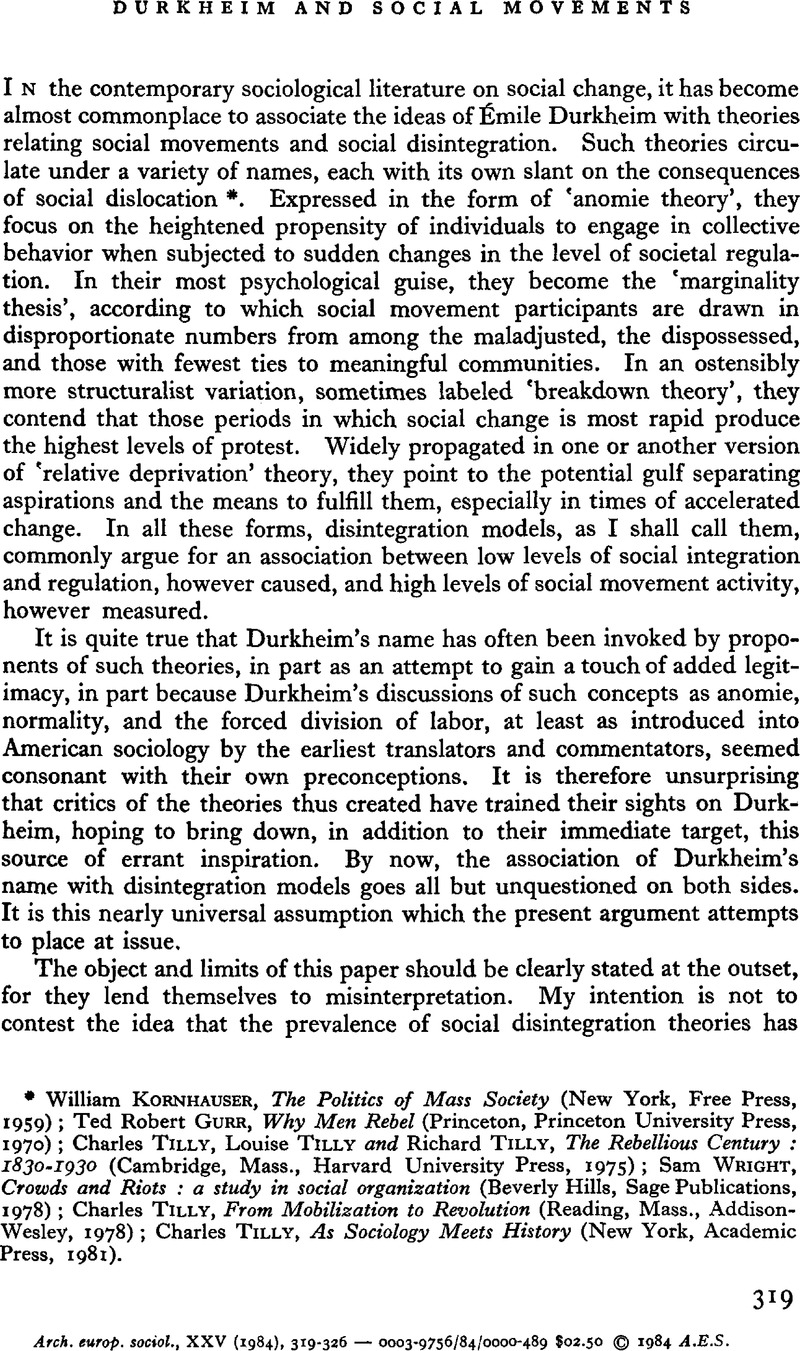Published online by Cambridge University Press: 28 July 2009

* Koknhauser, William, The Politics of Mass Society (New York, Free Press, 1959)Google Scholar;Gurr, Ted Robert, Why Men Rebel (Princeton, Princeton University Press, 1970)Google Scholar; Tilly, Charles, Tilly, Louise and Tilly, Richard, The Rebellious Century: 1830–1930 (Cambridge, Mass., Harvard University Press, 1975)CrossRefGoogle Scholar; Wright, Sam, Crowds and Riots: a study in social organization (Beverly Hills, Sage Publications, 1978)Google Scholar; Tilly, Charles, From Mobilization to Revolution (Reading, Mass., Addison-Wesley, 1978)Google Scholar; Tilly, Charles, As Sociology Meets History (New York, Academic Press, 1981)Google Scholar.
(1) Kornhauser, , op. cit. p. 88Google Scholar.
(2) Aya, Rod, Theories of revolution reconsidered: contrasting models of collective behavior, Theory and Society, III (1979), pp. 50–51Google Scholar.
(3) In both cases, the attempt to establish the classical lineage of these ideas would be more appropriately aimed at Tocqueville. Indeed, Kornhauser cites Tocqueville twice as often as Durkheim, and there could be no more concise formulation of the volcanic model than Tocqueville's speech in parliament anticipating the February Revolution of 1848. (See de Tocqueville, Alexis, Recollections (New York, Anchor Books, 1971), pp. 15–19)Google Scholar.
(4) Gurr, , op. cit. pp. 42–44Google Scholar.
(5) In The Anatomy of Revolution (New York, Vintage Books, 1965), p. 105Google Scholar, Brintton presents the interesting case of a theorist who specifically rejects Durklation heim (along with Marx) because he corville's rectly perceives that their systems are fundamentally antagonistic to the more psychological perspective which he prefers.
(6) Tilly, , op. cit. p. 107Google Scholar.
(7) Tilly, , Tilly, and Tilly, , op. cit. p. 4–6Google Scholar.The Tillys cite the following passage from Suicide: At the very moment when traditional rules have lost their authority, the richer prize offered these appetites stimulates them and amkes them more exigent and impatien of control. The state of di-regulation or anomy is thus further heightened by passions being less disciplined, precisely when they need more disciplining […] the struggle grows more violent and painful, both from being less controlled and because competition is greater. All classes contend among themselves because no established classification any longer exists.
While this quotation accurately conveys Durkheim's characteristic assumptions about the problematic insatiability of human nature, the manner in which it has been lifted from the text may leave the casual reader with the impression that Durkheim is relating the sudden failure of regulation to increased conflict among social classes. What the context clearly reveals is that Durkheim is using ‘class’ purely in the sense of ‘category’. The sentence with which Durkheim concludes the passage in the original—‘How could the desire to live not be weakened under such conditions’—makes it explicit that the conse quences of deregulation which Durkheim had in mind were variations in the rate of suicide.
(8) Tilly, , Tilly, and Tilly, , The Rebellious Century, pp. 273–274Google Scholar.
(9) Tilly, Ag Sociology Meets History p. 105Google Scholar.
(10) Originally circulated as Working Paper No. 155 by the Center for Research on Social Organization of the University of Michigan, this paper has since been published as chapter 4 of Charles Tilly, As Sociology Meets History.
(11) Tilly, , As Sociology Meets History, p. 102Google Scholar.
(12) Charles Tilly, From Mobilization to Revolution, op. cit.
(13) Ibid. p. 18.
(14) See, for example, Zablocki, Benjamin, The Joyful Community (Baltimore, Penguin Books, 1971)Google Scholar, and Schurmann, Franz, Ideology and Organization in Communist China (Berkeley, University of California Press, 1966)Google Scholar. The works cited in this section are put forward merely as illustrations and were chosen because in most cases they make their debt to Durkheim explicit. Durkheim's ideas, like the parallel insights of Marx and Weber, have been so thoroughly assimilated into the sociological perspective that they are commonly employed without acknowledgement.
(15) Compare Wright, Crowds and Riots, op. cit. and Kanter, Rosabeth Moss, Commitment and Community: communes and Utopias in sociological perspective (Cambridge, Mass., Harvard University Press, 1972)Google Scholar.
(16) See Turner, Ralph and Killian, Lewis, Collective Behavior (Englewood Cliffs, Prentice-Hall, 1957)Google Scholar.
(17) Touraine, Alain, The Voice and the Eye: an analysis of social movements (Cambridge, Cambridge University Press, 1981)Google Scholar.
(18) See Éenile Durkheim, Introduction to the sociology of the family, p. 205, in Traugott, Mark (ed.), Émile Durkheim on Institutional Analysis (Chicago, University of Chicago Press, 1978)Google Scholar.
(19) See Émile Durkheim, Review of Richard, pp. 137–138, in Trauoott (ed.), op. cit.
(20) Éimile Durkheim, The principles of 1789 and sociology, p. 41, in Bellah, Robert N. (ed.), Émile Durkheim on Morality and Society (Chicago, University of Chicago Press, 1973)Google Scholar.
(21) Durkheim specifically rejected the implication which he saw in Toennies' work that Gesellschaft, in contrast to Gemeinschaft, involved a mode of integration which depended on the artificial imposition of state authority to achieve its binding function. It was in order to emphasize the natural quality of both forms that he made his counter-intuitive decision to label the modern form ‘organic’, the primitive form ‘mechanical’. See Emile Durkity Heim. Review of Toennies, in Traugott, op. cit.
(22) Durkheim, Eimile, The Elementary Forms of the Religious Life (New York, Free Press, 1965), p. 241Google Scholar.
(23) Durkheim, ibid. p. 245.
(24) Durkheim, Émile, Sociology and Philosophy (New York, Free Press, 1974), p. 91Google Scholar. What these passages also demonstrate is that, in Durkheim's view, the state of social solidarity is significantly influenced by social organization. This of course was a point made as early as The Division of Labor where the change from mechanical to organic forms occurs as the result of changes in social volume and density. The latter refer to the demographic concentration, geographical distribution, and infrastructure arrangement of society as they affect the rate of social interactions. Much the same argument is advanced in Durkheim, Émile, Two Laws of Penal Evolution, in Traugott, (ed.), Émile Durkheim on Institutional Analysis, and The Evolution of Educational Thought (London, Routledge and Paul, 1977)Google Scholar.